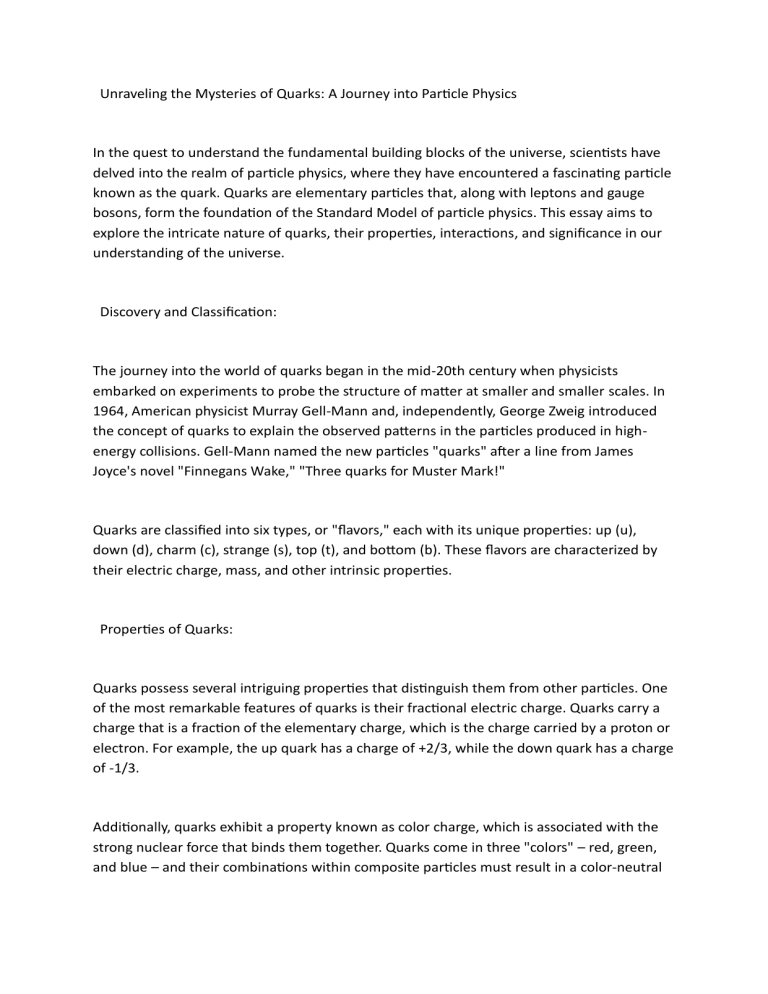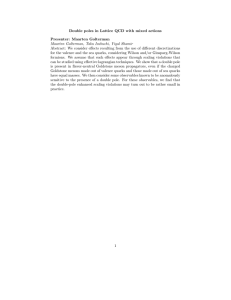
Unraveling the Mysteries of Quarks: A Journey into Particle Physics In the quest to understand the fundamental building blocks of the universe, scientists have delved into the realm of particle physics, where they have encountered a fascinating particle known as the quark. Quarks are elementary particles that, along with leptons and gauge bosons, form the foundation of the Standard Model of particle physics. This essay aims to explore the intricate nature of quarks, their properties, interactions, and significance in our understanding of the universe. Discovery and Classification: The journey into the world of quarks began in the mid-20th century when physicists embarked on experiments to probe the structure of matter at smaller and smaller scales. In 1964, American physicist Murray Gell-Mann and, independently, George Zweig introduced the concept of quarks to explain the observed patterns in the particles produced in highenergy collisions. Gell-Mann named the new particles "quarks" after a line from James Joyce's novel "Finnegans Wake," "Three quarks for Muster Mark!" Quarks are classified into six types, or "flavors," each with its unique properties: up (u), down (d), charm (c), strange (s), top (t), and bottom (b). These flavors are characterized by their electric charge, mass, and other intrinsic properties. Properties of Quarks: Quarks possess several intriguing properties that distinguish them from other particles. One of the most remarkable features of quarks is their fractional electric charge. Quarks carry a charge that is a fraction of the elementary charge, which is the charge carried by a proton or electron. For example, the up quark has a charge of +2/3, while the down quark has a charge of -1/3. Additionally, quarks exhibit a property known as color charge, which is associated with the strong nuclear force that binds them together. Quarks come in three "colors" – red, green, and blue – and their combinations within composite particles must result in a color-neutral state. This phenomenon is described by the theory of quantum chromodynamics (QCD), which governs the interactions of quarks and gluons, the carriers of the strong force. Furthermore, quarks have an intrinsic property called spin, which is a fundamental characteristic related to their angular momentum. Quarks are fermions, meaning they have half-integer spin values (1/2), obeying the Pauli exclusion principle. Interactions and Bound States: Quarks interact with each other through the exchange of gluons, the force carriers of the strong interaction. The strong force is responsible for binding quarks together to form composite particles called hadrons. Hadrons are classified into two categories: baryons, which are made up of three quarks (e.g., protons and neutrons), and mesons, composed of a quark-antiquark pair. The interactions between quarks are characterized by the confinement of quarks within hadrons. Due to the nature of the strong force, quarks cannot exist in isolation but are always confined within composite particles. This phenomenon explains why free quarks have never been observed in experiments and why the strong force becomes stronger as quarks are pulled farther apart, preventing their separation. Experimental Evidence and Collider Physics: Experimental evidence supporting the existence of quarks has been obtained through highenergy particle colliders such as the Large Hadron Collider (LHC) at CERN. Collisions between protons or other high-energy particles in these accelerators produce showers of secondary particles, providing insights into the underlying structure of matter. One of the landmark discoveries in particle physics was the observation of the top quark, the most massive of all quarks, at Fermilab in 1995. The detection of the top quark completed the family of six quarks predicted by the Standard Model. Furthermore, experiments at the LHC have contributed to our understanding of quark-gluon plasma, a state of matter believed to have existed in the early universe microseconds after the Big Bang. By colliding heavy ions at ultrahigh energies, physicists can recreate conditions similar to those in the early universe, allowing them to study the behavior of quarks and gluons in extreme conditions. Beyond the Standard Model: While the Standard Model has been remarkably successful in describing the known particles and their interactions, it is not without its limitations. Several phenomena, such as the existence of dark matter, the matter-antimatter asymmetry in the universe, and the hierarchy problem, remain unexplained within the framework of the Standard Model. As physicists continue to push the boundaries of our understanding, they explore theories beyond the Standard Model, such as supersymmetry, string theory, and grand unified theories (GUTs). These theories propose extensions to the existing framework and predict the existence of new particles, including exotic forms of quarks. Conclusion: In conclusion, quarks stand as enigmatic entities at the frontier of particle physics, offering profound insights into the nature of matter and the universe. From their fractional electric charges to their colorful interactions mediated by the strong force, quarks embody the complexity and elegance of the subatomic world. Through experimental exploration and theoretical inquiry, scientists strive to unlock the secrets of quarks and unravel the mysteries of the cosmos, paving the way for new discoveries and deeper understanding in the realm of fundamental physics.


